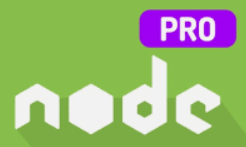Node.js Developer Roadmap for 2022
Updated: February 11, 2022•9 min read

JavaScript
- Arrow Functions
- Types
- Expressions
- Functions
- Lexical Structures
- this
- Loops and Scope
- Arrays
- Template Literals
- Strict Mode
- ES6/ES7
- Timers
- Promises
- Closures
- The Event Loop
- Async programming and callbacks
Node.js Basics
Event Emitters: They are objects in Node.js that trigger events by sending a message to signal that an action was completed. We can also write our own code that listens to events from an event emitter. For example, if you have done some frontend work, then you probably know how much interaction we need to handle in our applications, such as mouse clicks, keyboard button presses, and other mouse movements. Similarly, on the backend environment in Node.js, we can build a similar system using the events module, which offers EventEmitter class which we use to handle our events.
Callbacks: These are functions called when a task is completed, which prevents any kind of blocking while allowing the rest of the code to run in the meantime. As we have to work with a lot of asynchronous tasks in Node.js, we need them everywhere for making seamless and faster applications. For example,
Buffers: A class called Buffer in Node.js is designed to handle raw binary data. They correspond to some raw memory allocated outside V8. Buffers are an array of integers that can’t be resized having a whole bunch of methods specifically for binary data. For example, the integers in buffer represent a byte with limited values from 0 to 255 inclusive, if you console.log() to print a Buffer instance, a chain of values in hexadecimal will be received.
Module System: As a part of the Node.js ecosystem you will be using the Module for implementing complex functionality by just using the Modules provided by Node.js, these are JavaScript files that contain all the organized and complex features that anyone can reuse through the Node.js application.
Development Skills
Version Control Systems (Git, GitHub): You don’t want to be in a situation where you mess up something in your code while having no idea how to revert it. Using VCS like Git you can manage large scale projects & if you are already pretty familiar with using VCS then make sure that you have strong fundamental of Version Control Systems.
HTTP/HTTPS protocols: A fundamental knowledge of how the data is transferred using the transfer protocols will make you a better Node.js developer, a good understanding of how HTTP and HTTPS work is something every backend developer should understand well enough. HTTPS uses an encryption protocol known as Transport Layer Security (TLS)to encrypt communications. There is a lot to learn in the backend environment and it might get a little foggy for you if you had no idea how the web works, there are 4 request methods responsible for any basic communication on the web:
- GET: Used to retrieve a representation of a resource
- POST: Used to create new resources
- PUT: Used to update capabilities
- PATCH: Used to modify capabilities
- DELETE: Used to delete a resource identified by a URL
- OPTIONS: Request permitted communication option for a given URL or server
Web Frameworks
Express.js: Provides a very minimal interface and tools that are required to build our application, quite flexible to use, and comes with numerous modules available on npm which can be plugged directly into Express.
Koa.js: If you are looking to build robust applications that are future proof and easy to maintain then Koa.js is a good choice. A Koa application is an object containing an array of some middleware functions that are later executed in a manner of stacks.
Nest.js: Inspired by Angular and built with TypeScript, uses Express.js under the hood which makes it compatible with most of Express middleware. You can build an efficient and scalable application with Nest.js as it provides a great modular structure for organizing code into separate modules.
Database Management
SQL Server: A relational database management system developed by Microsoft, it supports ANSI SQL (a standard SQL language). However, SQL comes with its own implementations.
MySQL: Another great database management system that allows you to mage relational databases. Open-source backend software developed by Oracle, also with MySQL we get the flexibility of choices as we can change the source code according to the needs. MySQL is a pretty easy alternative as compared to Oracle Database & Microsoft SQL server.
PostgreSQL: Developed by a worldwide team of developers as it is open source. It runs on all major operating systems including Linux, UNIX & Windows. PostgreSQL supports a large part of the SQL standard while offering some great features such as Complex SQL queries, Foreign Keys, Trigger, Transactions, Multiversion concurrency control (MVCC), Streatimg Repllicartons, etc.
MariaDB: An improved version of MySQL that comes which various inbuilt powerful features, security, and performance improvements that you will not find in MySQL. There are several reasons why you should opt for MariaDB instead of MySQL for large-scale applications. For example, MariaDB has a larger connection pool supporting up to 200,000+ connections whereas MySQL has a smaller connection pool. In short, MariaDB is faster than MySQL.
Cloud Database Services
Azure CosmosDB: A database service that is globally distributed, you can manage your data remotely, using cloud databases gave you many advantages as scaling and managing big applications becomes a bit easy with the tool that you can use to scale and distribute, all provided by Microsoft Azure. Also, it supports multiple data models using one backend, which means it can be used for the document, key-value, relational & graph models. As it doesn’t rely on any schemas you can call it a NoSQL database, but it does support query language with ACID transaction support.
Amazon DynamoDB: As far as my knowledge Amazon DynamoDB is a great alternative if you already have some experience with SQL, it is a fully managed NoSQL database service providing faster and predictable performance with awesome scalability. You can create databases tables that can store and retrieve any amount of data and serve any level of request traffic
NoSQL Databases
MongoDB: A document-oriented NoSQL database specifically used for high volume data storage, as we have tables and rows in other relational databases, MongoDB uses collections and documents. A document consists of key-value pairs that are just basic unit of data in MongoDB & collection contains sets of documents and function which is the equivalent of relational databases tables
Redis: Using Redis we can work with databases, caching, and message broking. It uses data structures like strings, hashes, lists, sets, bitmaps, hyperloglogs & geospatial indexes to store data in the form of key-value pairs. If you are confused about where we use Redix, here is an example of that.
Let’s say in our application we have to deal with users who are authorized to take different actions within the application, each time we authenticate a user we have to derive their authorization for controlling acces in the applicaation.There is nothing buggy about this approach as we have good standards like JOSE while keeping our key material safe, but if our application has more than a couple of authorisations, the same becomes very hard to scale. And instead of sendind the list of authorization to the user, we can store the user’s authorization in some form of database and provide the user a key-value (known as a token) which they have to send us for authorization.
Apache Cassandra
A highly scalable with high-performance and distributed database designed to handle a large amount of data across many servers, with no single point of failure. Created at Facebook it differs from other relational database management systems. The distributed design is based on Amazon’s DynamoDB and the data model on Google’s BigTable.
Search Engines
Note: If you are thinking why do we need a search engine, then here is an example, we use Google as a search engine, but that’s itself a whole web based application. Solr and ElasticSearch are backend frameworks and if any type of data set is provided it creates an index on top of that while making that data available for search on a server. You can maintain a website with million of users with Solr as the search engine.
ElasticSearch
A search and analytics engine built on Apache Lucene and developed in Java. Using ElasticSearch you can store, and analyze huge volumes of data in real-time. As it searches the index instead of searching the text, great search performance is also achieved in ElasticSearch. At its core, it uses structure-based documents instead of tables and schemas that come with extensive REST APIs for storing and searching data. You can think of ElasticSearch as a server that processes JSON requests and giving you back JSON data.
Memory Cache
This technique is also commonly called caching as most of the time, the caching is associated with the memory in servers. In this technique, a portion of the server’s memory is used as a cache where we store all the data that is required to reduce network calls in our applications. In Node.js we have node-cache and memory-cache as some great libraries to handle memory cache in a Node server.
Distributed Cache
In this caching technique we combine the memory of multiple networks into a single memory data store which we later use as the final data cache to prove fast access to the data. This technique is especially used in a high volume of data and a huge number of network calls at the same time allows incremental expansion and scaling by adding more server memory to the cluster.
Socket.io
There is a lot when it comes to understanding real-time communication in Socket.IO if you are just getting started as a backend developer, the main logic behind real-time communication stands between the client and the server. It allows the flow of bi-directional data between the client & server, you can think of bi-directional data flow as the synchronous flow of data between two terminals to achieve the real-time communication behavior, these types of behavior are enabled when the client has Socket.IO in the browser along with the server integrated with Socket.IO package. And the data can be sent in the form of JSON requests.
REST
Before REST, APIs were developed around a remote procedure call (RPC) and the APIs looked like some locally executed code. Many technologies tried to solve this problem using RPC-like stacks to hide the root problem and after that REST was introduced to build web-based APIs in a better way.
In REST the architecture is styled with simple HTTP calls to communicate instead of complex options like COBRA, COM+, RPC. In REST the calls are messages based and rely on the HTTP standards to describe these messages. In the Node.js ecosystem, you can go for the node-rest-client and Axios, both serve pretty good service for faster web applications.
GraphQL
A great alternative to REST, GraphQL uses the APIs that prioritize giving clients exactly the data they request. A flexible and developer-friendly alternative, as you can deploy it even in an IDE known as GraphiQL. You also get the advantages to add or deprecate fields without impacting existing queries and build APIs with whatever method is preferred.
Unit Testing Frameworks
Jest: A very popular testing framework known for its simplicity and developed by Facebook. Among all the testing frameworks Jest has the best documentation with parallel testing support, which means that you can run each test in their own process to maximize performance.
Mocha: It serves the old standards of Unit Testing frameworks for Node applications and supports async operations like callbacks, promises with highly extensible and customizable assertions.
Chai: It can be used alongside Mocha and can be used as a TDD/BDD assertion library for Node.js that can be paired with any testing framework based on JavaScript.
